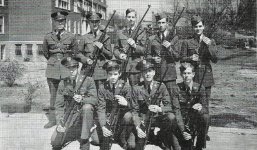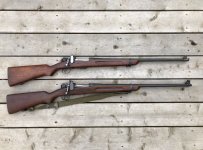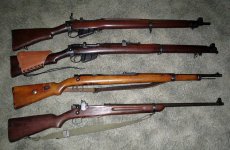In this case "M2" is short for "MerryChristmas 2" me.
I've wanted a Model 1922 or it's M1 or M2 iterations for quite a while now and this one has been sitting in a shop an hour or so away for a few years.
Last weekend it had apparently now been there long enough that I was able to negotiate an agreeable price, so I brought it home.
I've always like the sporter lines they used on these, similar to the NRA Sporters as well as the early Model 52s. They are reported to be very accurate shooters, on par with the early Model 52s.
Based on the 1903 receiver and with a heavy barrel it weighs in at a heavy but very nicely 9 lbs 7 oz with a Model 1907 sling attached.
The trigger is typical 2 stage military, but with minimal creep and a 2 1/2 pound pull.

It's well made with a very nicely engineered bolt in a modified 1903 receiver. I'm not an expert on them or their serial numbers but my take on it is that a low numbered receiver M2 receiver may indicate one of the early - and very unsuccessful - U.S. Gallery Rifle Caliber .22 Model 1903 rifles (introduced in 1907) that was rebuilt or reworked as an M2. That's based on records kept by Richard T. Colton, a historian at the Springfield Armory Museum. He has stated that many of the early rifles, including the U.S. Gallery Rifle caliber .22 Model 1903, were rebuilt and updated and possibly used to build the 1922 M1 and M2 models.
I suspect that is the case here. Rather than being marked as a "1922M2" (indicating a reworked M1922) or "1922M11" indicating a reworked 1922 M1, it's just marked "Cal. .22 M2" with the "M2" being struck slightly less deep than the rest.

The barrel is dated 7-42, so it's either one of the last M2s made (in this case from a 1903 gallery gun receiver), or it was made earlier in the M2 era (1933-1942) and was rebarreled at some point in its service with a leftover 1942 barrel.
The Lyman 48C sight was pretty stiff so I took it apart, cleaned it, lubricated it and re-assembled it and it now functions perfectly. I have a slide pointer and screw on the way since this one is missing both. With 1/2 MOA clicks in windage and elevation and plenty of elevation travel it should be fun for use on plates out to 200 yards or so. It's a superb sight and it's unfortunate that Lyman doesn't make receiver sights with that level of quality anymore.
Condition wise, the bore is excellent, the metal is in very good condition, and the stock is dark but has only a few small dents and handling marks. I've got some cheesecloth and pure tung oil coming tomorrow and I'll see if I can lift some of the dirt and oil out of it to lighten it up and bring back some of the color.

It's been windy today and it's supposed to be windier tomorrow, and windy again on Friday, but hopefully I can get it out on Christmas day or perhaps Saturday and see how it shoots at 50 yards and at long range.
I've wanted a Model 1922 or it's M1 or M2 iterations for quite a while now and this one has been sitting in a shop an hour or so away for a few years.
Last weekend it had apparently now been there long enough that I was able to negotiate an agreeable price, so I brought it home.
I've always like the sporter lines they used on these, similar to the NRA Sporters as well as the early Model 52s. They are reported to be very accurate shooters, on par with the early Model 52s.
Based on the 1903 receiver and with a heavy barrel it weighs in at a heavy but very nicely 9 lbs 7 oz with a Model 1907 sling attached.
The trigger is typical 2 stage military, but with minimal creep and a 2 1/2 pound pull.

It's well made with a very nicely engineered bolt in a modified 1903 receiver. I'm not an expert on them or their serial numbers but my take on it is that a low numbered receiver M2 receiver may indicate one of the early - and very unsuccessful - U.S. Gallery Rifle Caliber .22 Model 1903 rifles (introduced in 1907) that was rebuilt or reworked as an M2. That's based on records kept by Richard T. Colton, a historian at the Springfield Armory Museum. He has stated that many of the early rifles, including the U.S. Gallery Rifle caliber .22 Model 1903, were rebuilt and updated and possibly used to build the 1922 M1 and M2 models.
I suspect that is the case here. Rather than being marked as a "1922M2" (indicating a reworked M1922) or "1922M11" indicating a reworked 1922 M1, it's just marked "Cal. .22 M2" with the "M2" being struck slightly less deep than the rest.

The barrel is dated 7-42, so it's either one of the last M2s made (in this case from a 1903 gallery gun receiver), or it was made earlier in the M2 era (1933-1942) and was rebarreled at some point in its service with a leftover 1942 barrel.
The Lyman 48C sight was pretty stiff so I took it apart, cleaned it, lubricated it and re-assembled it and it now functions perfectly. I have a slide pointer and screw on the way since this one is missing both. With 1/2 MOA clicks in windage and elevation and plenty of elevation travel it should be fun for use on plates out to 200 yards or so. It's a superb sight and it's unfortunate that Lyman doesn't make receiver sights with that level of quality anymore.
Condition wise, the bore is excellent, the metal is in very good condition, and the stock is dark but has only a few small dents and handling marks. I've got some cheesecloth and pure tung oil coming tomorrow and I'll see if I can lift some of the dirt and oil out of it to lighten it up and bring back some of the color.

It's been windy today and it's supposed to be windier tomorrow, and windy again on Friday, but hopefully I can get it out on Christmas day or perhaps Saturday and see how it shoots at 50 yards and at long range.



















